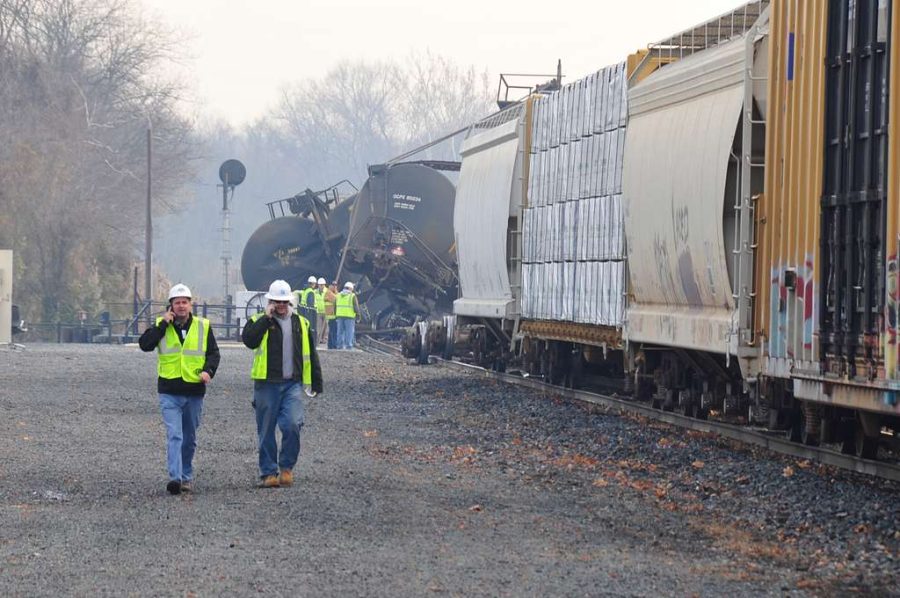Ohio train derailment contaminates soil and water in surrounding areas
March 13, 2023
Thirty-eight cars of a Norfolk Southern freight train derailed in East Palestine, Ohio due to a mechanical failure caused by an overheated wheel bearing axle on Feb 3.
The train was transporting hazardous and flammable materials from Madison, Illinois to Conway, Pennsylvania. Some of these materials included vinyl chloride, butyl acrylate, 2-ethylhexyl acrylate, combustible liquids and benzene residue.
Once officials arrived at the scene, the Environmental Protection Agency began its process of decontamination and investigation.
At the state officials’ request, emergency crews conducted a controlled burn of several railcars, which led to the release of hydrogen chloride and phosgene — byproducts of vinyl chloride — into the air. Residents within a mile radius of the site were evacuated and an emergency response was initiated by federal and state agencies in Ohio, Pennsylvania and West Virginia.
Officials at the site discovered contaminated runoff at two sites — Sulphur Run and Laslie Run –on Feb. 5. The Norfolk Southern Emergency response crew installed booms and underflow dams to restrict the flow and collect samples. The dams and water bypass prevented further contamination of downstream waters and stopped the remaining contaminants from entering the stream.
Although the derailment site was in East Palestine, Ohio, several states, like Pennsylvania, West Virginia, Kentucky, Indiana and Illinois, were affected because they all use the Ohio River basin as a source of drinking water. Contaminants that entered the ground water in East Palestine affected everyone.
The West Virginian subsidiary of American Water reported “that it had not detected any changes in the water at its Ohio River intake site.”
The EPA started to dispose of contaminated soil and water at an Indiana landfill dumpsite on Feb. 26. Concerns were raised once people learned the site had failed multiple environmental guidelines in the past. The disposal process is on pause as officials are looking for more suitable dump sites.
Residents who returned to East Palestine reported health issues and complained about dead livestock. Despite the EPA reporting no air or water contaminants and all levels of the pollutants are in acceptable ranges, residents are not convinced.
People have shared videos online of vet reports about their animals who were fine prior to the derailment but are now succumbing to mysterious illnesses. A pet cat living near the derailment site had an enlarged heart and fluid in his lungs “that was triggered by the vinyl chloride poisoning” according to its vet.
Vinyl chloride is a chemical compound used in plastic products production and as a binding agent in paint and glue. Traditionally, vinyl chloride is created and used in the same facility as plastic products. It is in a liquid state on occasions where it must be transported.
People can be exposed to vinyl chloride through inhalation and, in some circumstances, through contaminated ground water.
The exposure of vinyl chlorine in humans showed long term effects in the liver. Exposure to vinyl chlorine can lead to an increased chance of cancer, affecting the central nervous system, cardiovascular, reproductive and muscular systems.
Symptoms of vinyl chloride exposure include decreased blood flow to the fingers, liver tumors, decrease in bone strength, joint and muscle pain, fetal deformation, decreased body weight, pneumonitis, lung cancer, decreased heart weight, rashes, blisters and increased collagen production.
Along with vinyl chloride, the freight train was carrying other hazardous chemicals and materials like powder flakes. Some of the chemicals present in the trains like benzene, diethylene glycol, isobutylene can cause health issues such as unconsciousness, increased cancer risk, anemia, coma, seizures and hepatorenal failure. In stronger concentrations, these chemicals can cause neurological effects such as nausea, sleep disturbances, visual and hearing disturbancesand loss of consciousness.
The chemicals on the train are not only harmful to humans, but also the environment. When diethylene glycol and propylene glycol are burned, they can create byproducts like nitrous oxides and sulfur dioxide that contribute to global warming.
Diethylene glycol, can disrupt the reproductive cycles of fish and aquatic organisms when released into the atmosphere or improperly disposed. The contaminants of the derailment affected about 7.5 miles of stream, killing an estimated 3,500 fish.
The EPA and other officials are working towards minimizing the harms of these chemicals on areas surrounding the train derailment.







